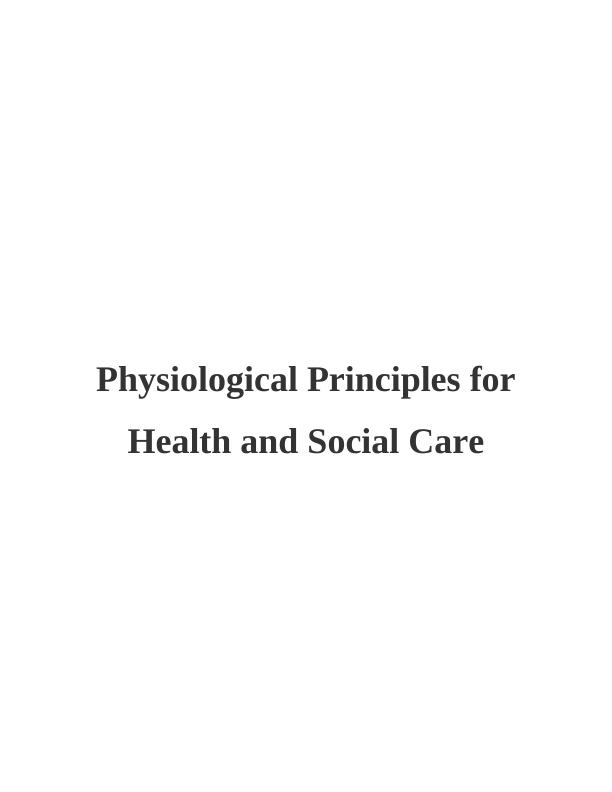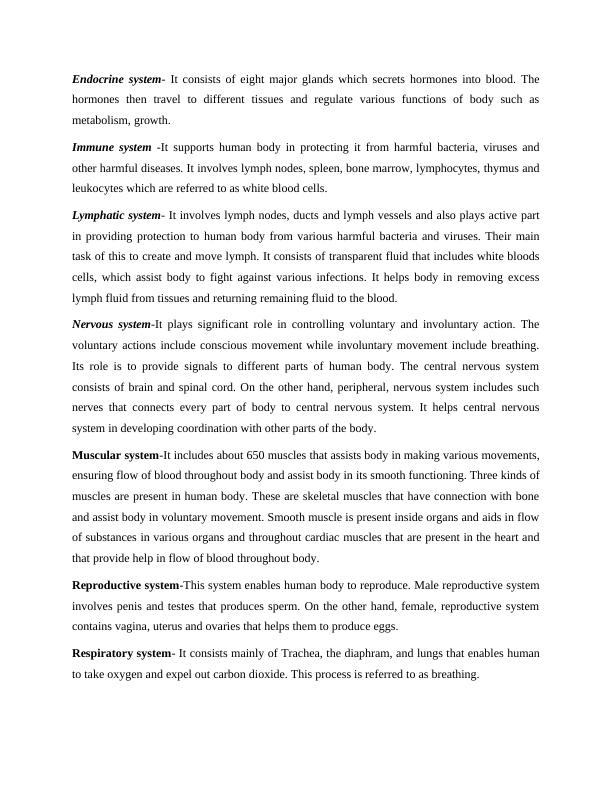Physiological Principles for Health and Social Care
Added on 2023-03-24
17 Pages5840 Words91 Views
Physiological Principles for
Health and Social Care
Health and Social Care

TABLE OF CONTENTS
INTRODUCTION...........................................................................................................................3
1.1 Main economical features of human body.......................................................................3
1.2 The interaction between Skeletal, muscular and cardiovascular system..........................5
TASK 2............................................................................................................................................6
2.1 Explaining normal body response to everyday activities.................................................6
2.2 Body response are explained by cellular, tissue structure and physiology...................7
2.3 The body coordinate its internal activities........................................................................8
TASK 3............................................................................................................................................9
3.1 Use of routine measures in health and social care............................................................9
3.3 The way information about body functioning may inform care planning for individual10
TASK 4..........................................................................................................................................11
4.1 Explaining the way age may affect body structure........................................................11
4.2 Assess the impact of common disorders on body structure and functioning.................12
4.3 Relate the effects of common disorders and infection to the care routinely given to
individuals affected by them................................................................................................13
CONCLUSION..............................................................................................................................13
REFERENCES..............................................................................................................................15
Books and journal:.........................................................................................................................15
INTRODUCTION...........................................................................................................................3
1.1 Main economical features of human body.......................................................................3
1.2 The interaction between Skeletal, muscular and cardiovascular system..........................5
TASK 2............................................................................................................................................6
2.1 Explaining normal body response to everyday activities.................................................6
2.2 Body response are explained by cellular, tissue structure and physiology...................7
2.3 The body coordinate its internal activities........................................................................8
TASK 3............................................................................................................................................9
3.1 Use of routine measures in health and social care............................................................9
3.3 The way information about body functioning may inform care planning for individual10
TASK 4..........................................................................................................................................11
4.1 Explaining the way age may affect body structure........................................................11
4.2 Assess the impact of common disorders on body structure and functioning.................12
4.3 Relate the effects of common disorders and infection to the care routinely given to
individuals affected by them................................................................................................13
CONCLUSION..............................................................................................................................13
REFERENCES..............................................................................................................................15
Books and journal:.........................................................................................................................15

INTRODUCTION
The focus of the report is on gaining information about those body functions which has
great effect on health and social care. The project will include study of main structures of human
body and developing suitable nomenclature in order to work with health professionals. It will
also include details about various structures, their positions and function in human body.
1.1 Main economical features of human body
The human body consist of many biological systems that are meant to perform particular
functions that are very essential for everyday living (Schoenherr and Hamstra, 2017) Various
biological system and their features are:
Circulatory system: The function of circulatory system is to ensure smooth flow of blood cells
throughout human body. Circulatory system consists of various elements such as heart, blood,
blood vessels, arteries and veins.
Digestive system: It consists of series of interconnected organs that works together in order to
enable human body to breakdown and absorb food and remove waste from body. It involves the
mouth, Oesophagus, stomach, large and small intestine, rectum and anus. Significant role is also
being played by liver and pancreas as they produce digestive juices.
The focus of the report is on gaining information about those body functions which has
great effect on health and social care. The project will include study of main structures of human
body and developing suitable nomenclature in order to work with health professionals. It will
also include details about various structures, their positions and function in human body.
1.1 Main economical features of human body
The human body consist of many biological systems that are meant to perform particular
functions that are very essential for everyday living (Schoenherr and Hamstra, 2017) Various
biological system and their features are:
Circulatory system: The function of circulatory system is to ensure smooth flow of blood cells
throughout human body. Circulatory system consists of various elements such as heart, blood,
blood vessels, arteries and veins.
Digestive system: It consists of series of interconnected organs that works together in order to
enable human body to breakdown and absorb food and remove waste from body. It involves the
mouth, Oesophagus, stomach, large and small intestine, rectum and anus. Significant role is also
being played by liver and pancreas as they produce digestive juices.

Endocrine system- It consists of eight major glands which secrets hormones into blood. The
hormones then travel to different tissues and regulate various functions of body such as
metabolism, growth.
Immune system -It supports human body in protecting it from harmful bacteria, viruses and
other harmful diseases. It involves lymph nodes, spleen, bone marrow, lymphocytes, thymus and
leukocytes which are referred to as white blood cells.
Lymphatic system- It involves lymph nodes, ducts and lymph vessels and also plays active part
in providing protection to human body from various harmful bacteria and viruses. Their main
task of this to create and move lymph. It consists of transparent fluid that includes white bloods
cells, which assist body to fight against various infections. It helps body in removing excess
lymph fluid from tissues and returning remaining fluid to the blood.
Nervous system-It plays significant role in controlling voluntary and involuntary action. The
voluntary actions include conscious movement while involuntary movement include breathing.
Its role is to provide signals to different parts of human body. The central nervous system
consists of brain and spinal cord. On the other hand, peripheral, nervous system includes such
nerves that connects every part of body to central nervous system. It helps central nervous
system in developing coordination with other parts of the body.
Muscular system-It includes about 650 muscles that assists body in making various movements,
ensuring flow of blood throughout body and assist body in its smooth functioning. Three kinds of
muscles are present in human body. These are skeletal muscles that have connection with bone
and assist body in voluntary movement. Smooth muscle is present inside organs and aids in flow
of substances in various organs and throughout cardiac muscles that are present in the heart and
that provide help in flow of blood throughout body.
Reproductive system-This system enables human body to reproduce. Male reproductive system
involves penis and testes that produces sperm. On the other hand, female, reproductive system
contains vagina, uterus and ovaries that helps them to produce eggs.
Respiratory system- It consists mainly of Trachea, the diaphram, and lungs that enables human
to take oxygen and expel out carbon dioxide. This process is referred to as breathing.
hormones then travel to different tissues and regulate various functions of body such as
metabolism, growth.
Immune system -It supports human body in protecting it from harmful bacteria, viruses and
other harmful diseases. It involves lymph nodes, spleen, bone marrow, lymphocytes, thymus and
leukocytes which are referred to as white blood cells.
Lymphatic system- It involves lymph nodes, ducts and lymph vessels and also plays active part
in providing protection to human body from various harmful bacteria and viruses. Their main
task of this to create and move lymph. It consists of transparent fluid that includes white bloods
cells, which assist body to fight against various infections. It helps body in removing excess
lymph fluid from tissues and returning remaining fluid to the blood.
Nervous system-It plays significant role in controlling voluntary and involuntary action. The
voluntary actions include conscious movement while involuntary movement include breathing.
Its role is to provide signals to different parts of human body. The central nervous system
consists of brain and spinal cord. On the other hand, peripheral, nervous system includes such
nerves that connects every part of body to central nervous system. It helps central nervous
system in developing coordination with other parts of the body.
Muscular system-It includes about 650 muscles that assists body in making various movements,
ensuring flow of blood throughout body and assist body in its smooth functioning. Three kinds of
muscles are present in human body. These are skeletal muscles that have connection with bone
and assist body in voluntary movement. Smooth muscle is present inside organs and aids in flow
of substances in various organs and throughout cardiac muscles that are present in the heart and
that provide help in flow of blood throughout body.
Reproductive system-This system enables human body to reproduce. Male reproductive system
involves penis and testes that produces sperm. On the other hand, female, reproductive system
contains vagina, uterus and ovaries that helps them to produce eggs.
Respiratory system- It consists mainly of Trachea, the diaphram, and lungs that enables human
to take oxygen and expel out carbon dioxide. This process is referred to as breathing.

End of preview
Want to access all the pages? Upload your documents or become a member.
Related Documents
Report on Principles for Health and Social Carelg...
|16
|5368
|107
Basic Anatomy and Physiologylg...
|7
|1686
|190
Homeostasis & Organisation of matterlg...
|7
|1320
|277
Anatomy and Physiology Essay 3&4 on Human Vascular System and Facial Arterylg...
|4
|1339
|440
The Lymphatic Systemlg...
|10
|668
|86
Biology Assignmentlg...
|11
|2722
|240
